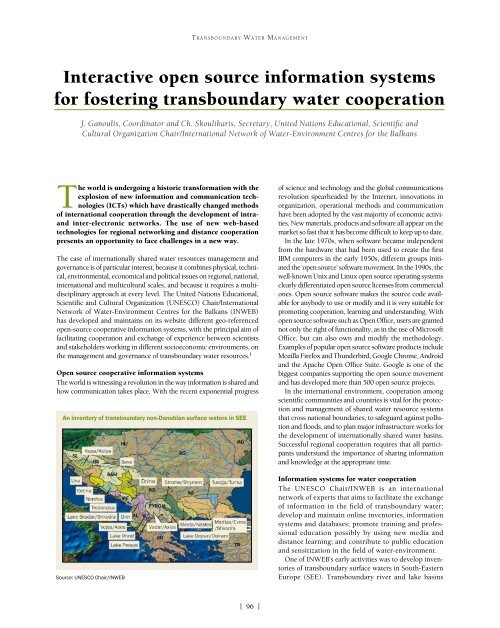222893e
222893e
222893e
You also want an ePaper? Increase the reach of your titles
YUMPU automatically turns print PDFs into web optimized ePapers that Google loves.
TRANSBOUNDARY WATER MANAGEMENTInteractive open source information systemsfor fostering transboundary water cooperationJ. Ganoulis, Coordinator and Ch. Skoulikaris, Secretary, United Nations Educational, Scientific andCultural Organization Chair/International Network of Water-Environment Centres for the BalkansThe world is undergoing a historic transformation with theexplosion of new information and communication technologies(ICTs) which have drastically changed methodsof international cooperation through the development of intraandinter-electronic networks. The use of new web-basedtechnologies for regional networking and distance cooperationpresents an opportunity to face challenges in a new way.The case of internationally shared water resources management andgovernance is of particular interest, because it combines physical, technical,environmental, economical and political issues on regional, national,international and multicultural scales, and because it requires a multidisciplinaryapproach at every level. The United Nations Educational,Scientific and Cultural Organization (UNESCO) Chair/InternationalNetwork of Water-Environment Centres for the Balkans (INWEB)has developed and maintains on its website different geo-referencedopen-source cooperative information systems, with the principal aim offacilitating cooperation and exchange of experience between scientistsand stakeholders working in different socioeconomic environments, onthe management and governance of transboundary water resources. 1Open source cooperative information systemsThe world is witnessing a revolution in the way information is shared andhow communication takes place. With the recent exponential progressAn inventory of transboundary non-Danubian surface waters in SEESource: UNESCO Chair/INWEBof science and technology and the global communicationsrevolution spearheaded by the Internet, innovations inorganization, operational methods and communicationhave been adopted by the vast majority of economic activities.New materials, products and software all appear on themarket so fast that it has become difficult to keep up to date.In the late 1970s, when software became independentfrom the hardware that had been used to create the firstIBM computers in the early 1950s, different groups initiatedthe ‘open source’ software movement. In the 1990s, thewell-known Unix and Linux open source operating systemsclearly differentiated open source licenses from commercialones. Open source software makes the source code availablefor anybody to use or modify and it is very suitable forpromoting cooperation, learning and understanding. Withopen source software such as Open Office, users are grantednot only the right of functionality, as in the use of MicrosoftOffice, but can also own and modify the methodology.Examples of popular open source software products includeMozilla Firefox and Thunderbird, Google Chrome, Androidand the Apache Open Office Suite. Google is one of thebiggest companies supporting the open source movementand has developed more than 500 open source projects.In the international environment, cooperation amongscientific communities and countries is vital for the protectionand management of shared water resource systemsthat cross national boundaries, to safeguard against pollutionand floods, and to plan major infrastructure works forthe development of internationally shared water basins.Successful regional cooperation requires that all participantsunderstand the importance of sharing informationand knowledge at the appropriate time.Information systems for water cooperationThe UNESCO Chair/INWEB is an internationalnetwork of experts that aims to facilitate the exchangeof information in the field of transboundary water;develop and maintain online inventories, informationsystems and databases; promote training and professionaleducation possibly by using new media anddistance learning; and contribute to public educationand sensitization in the field of water-environment.One of INWEB’s early activities was to develop inventoriesof transboundary surface waters in South-EasternEurope (SEE). Transboundary river and lake basins[ 96 ]


